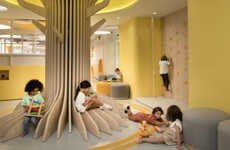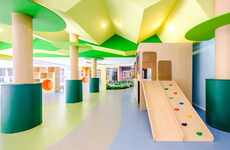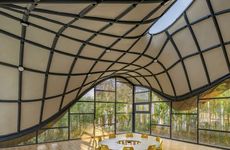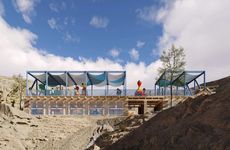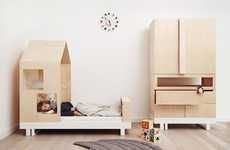
This Preschool's Interior Stimulates Children with Vibrant Colors
Kalin Ned — February 14, 2018 — Art & Design
References: studiorenesa & archdaily
The geometrically uniform and vibrantly varying elements in this preschool design by Renesa Architecture Design Interiors Studio were informed by children's cognitive development. The pre-nursery in New Delhi, India builds on a "Renaissance of Art" that engages creative expression, curiosity and exploration within younger audiences.
To aid the natural, social and physical development of students, the preschool design is constructive to the child's knowledge and understanding of sizable spaces. The building is not plagued by a cluster of different elements. Instead, the modern boxed structure takes one or two motifs and presents them in different variations and colors. The facade of the establishment features a generous courtyard to facilitate play and the elaborately Tetris-like tiles add a welcome component to the preschool design.
Photo Credits: Yibhor Yadav
To aid the natural, social and physical development of students, the preschool design is constructive to the child's knowledge and understanding of sizable spaces. The building is not plagued by a cluster of different elements. Instead, the modern boxed structure takes one or two motifs and presents them in different variations and colors. The facade of the establishment features a generous courtyard to facilitate play and the elaborately Tetris-like tiles add a welcome component to the preschool design.
Photo Credits: Yibhor Yadav
Trend Themes
1. Cognitive Developmental Architecture - Designing buildings that take into consideration the cognitive development of their occupants to create spaces constructive to their understanding and knowledge.
2. Stimulating Interior Design - Creating visually exciting spaces that engages creative expression, curiosity and exploration within younger audiences.
3. Geometric Variation Designs - Using geometrically uniform and vibrantly varying elements to create playful and dynamic spaces.
Industry Implications
1. Education - Using cognitive developmental architecture and stimulating interior design to create enhanced learning environments.
2. Real Estate - Incorporating geometric variation designs to create visually exciting and playful spaces for occupants and potential occupants.
3. Architecture and Design - Developing innovative design concepts that challenge traditional notions of building design and construction methodologies.
4.4
Score
Popularity
Activity
Freshness


